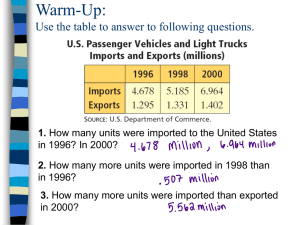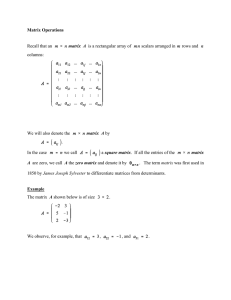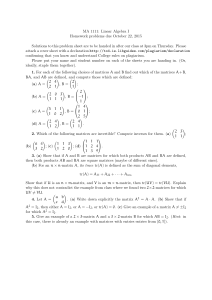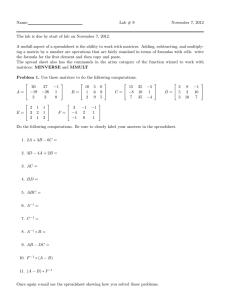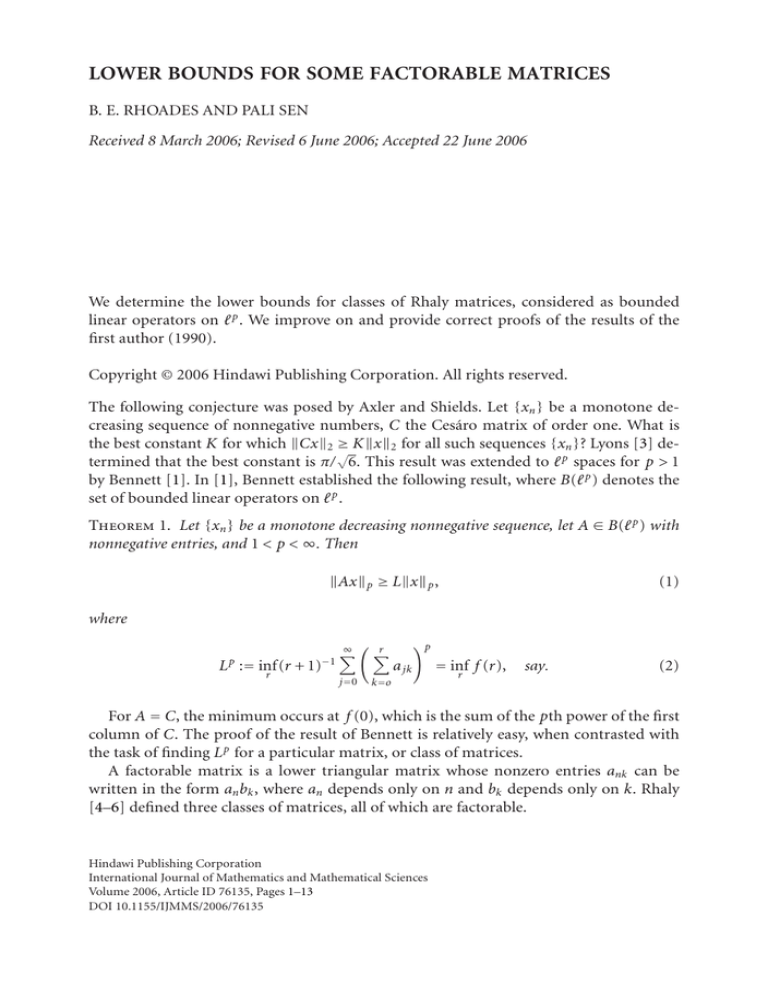
LOWER BOUNDS FOR SOME FACTORABLE MATRICES
B. E. RHOADES AND PALI SEN
Received 8 March 2006; Revised 6 June 2006; Accepted 22 June 2006
We determine the lower bounds for classes of Rhaly matrices, considered as bounded
linear operators on p . We improve on and provide correct proofs of the results of the
first author (1990).
Copyright © 2006 Hindawi Publishing Corporation. All rights reserved.
The following conjecture was posed by Axler and Shields. Let {xn } be a monotone decreasing sequence of nonnegative numbers, C the Cesáro matrix of order one. What is
≥ K x2 for all such sequences {xn }? Lyons [3] dethe best constant K for which Cx2 √
termined that the best constant is π/ 6. This result was extended to p spaces for p > 1
by Bennett [1]. In [1], Bennett established the following result, where B( p ) denotes the
set of bounded linear operators on p .
Theorem 1. Let {xn } be a monotone decreasing nonnegative sequence, let A ∈ B( p ) with
nonnegative entries, and 1 < p < ∞. Then
Ax p ≥ Lx p ,
(1)
where
p
L := inf (r + 1)
r
−1
∞
j =0
r
p
a jk
k =o
= inf f (r),
r
say.
(2)
For A = C, the minimum occurs at f (0), which is the sum of the pth power of the first
column of C. The proof of the result of Bennett is relatively easy, when contrasted with
the task of finding L p for a particular matrix, or class of matrices.
A factorable matrix is a lower triangular matrix whose nonzero entries ank can be
written in the form an bk , where an depends only on n and bk depends only on k. Rhaly
[4–6] defined three classes of matrices, all of which are factorable.
Hindawi Publishing Corporation
International Journal of Mathematics and Mathematical Sciences
Volume 2006, Article ID 76135, Pages 1–13
DOI 10.1155/IJMMS/2006/76135
2
Factorable matrices
In [8], Rhoades investigated the lower bounds question for the Rhaly matrices, and
obtained some partial results. In this paper, we return to the study of the Rhaly matrices,
as special cases of factorable matrices. This paper differs from [8] in three important
respects. First, one general result is proved, and the theorems of [8] then follow as special
cases. Second, the results of [8] are extended to all p > 1. Third, as an application of the
general procedure developed here, we are able to provide a new proof of [7, Theorem 1]
as well as to verify the conjecture that, for the weighted mean methods with pn = (n + 1)α ,
α ≥ 1, L p = f (0).
For any sequence {xn }, the forward difference operator Δ is defined by Δxn = xn − xn+1 ,
and Δm+1 xn = Δ(Δm xn ).
Theorem 2. Let A be a factorable matrix with positive entries, row sums tn , and {an } monotone decreasing. Then sufficient conditions for f (0) = L p are that
p
p
Δyr < 0,
Δ2
Δ2 yr > 0,
1
p
Δyr
(3)
≤ 0,
(4)
where yr = tr /ar ,
p
p
ar+1 Δyr+1
≥ 0,
p
r →∞
Δ2 yr
lim
p
t0 + 2Δy0
∞
(5)
p
a j ≤ 0.
j =1
(6)
Proof. With
tn = an
n
bk ,
k =0
yn =
∞
r
1 f (r) =
a jk
r + 1 j =0 k =0
=
tn
,
an
p
j
r
1
a jk
r + 1 j =0 k =0
P
+
∞
j =r+1
r
p
a jk
(7)
k =0
r
∞
1
p
p p
t j + yr
aj ,
=
r + 1 j =0
j =r+1
p
r
yr
yr ar+1
1
t
p
t − r+1 +
+Δ
(r + 1)(r + 2) j =0 j r + 2
r +1
r +1
Note that
p
p p
p
f (r) − f (r + 1) =
p p
p p
ar+1 yr+1
yr ar+1 yr ar+1
t
− r+1 +
=
−
r +2
r +1
r +1
r +2
p
p
= ar+1 Δ
p
∞
j =r+2
p
aj .
yr
.
r +1
(8)
B. E. Rhoades and P. Sen 3
Thus
r
p
p
yr
1
f (r) − f (r + 1) =
t +Δ
(r + 1)(r + 2) j =0 j
r +1
∞
j =r+1
p
aj .
(9)
Define
g(r) = (r + 1)(r + 2) f (r) − f (r + 1)
=
r
j =0
p
tj
p
yr
+ (r + 1)(r + 2)Δ
r +1
∞
(10)
p
j =r+2
aj .
Then
g(r) − g(r
p
+ 1) = −tr+1 + (r
p
p
yr
yr+1
+ 2) (r + 1)Δ
− (r + 3)Δ
r +1
r +2
p
yr
+ (r + 1)(r + 2)Δ
r +1
∞
j =r+2
p
aj
(11)
p
ar+1 .
But
p
p
yr
yr+1
(r + 1)Δ
− (r + 3)Δ
r +1
r +2
= (r + 1)
p
= yr −
p
p
p
p
yr
yr+1
yr+1
yr+2
−
−
− (r + 3)
r +1 r +2
r +2 r +3
p
p
(r + 1)yr+1 (r + 3)yr+1
p
p
−
+ yr+2 = Δ2 yr ,
r +2
r +2
p
− tr+1 + (r + 1)(r + 2)Δ
= − ar+1 yr+1
p
p
yr
r +1
(12)
p
ar+1
+ (r + 1)(r + 2)
p
p
yr
yr+1 p
−
a
r + 1 r + 2 r+1
p p
p
p p
= ar+1 − yr+1 + (r + 2)yr − (r + 1)yr+1 = ar+1 (r + 2)Δyr p .
Thus
p
g(r) − g(r + 1) = (r + 2)ar+1 Δyr+1
p
p
+ (r + 2)Δ2 yr
∞
j =r+1
p
aj .
(13)
4
Factorable matrices
Define
p
h(r) =
p
∞
g(r) − g(r + 1) ar+1 Δyr
p
=
+
aj ,
p
p
(r + 2)Δ2 yr
Δ2 yr
j =r+2
p
p
p
a Δyr
Δy
p
h(r) − h(r + 1) = r+12 p + ar+2 1 − 2 r+1
p
Δ yr
Δ yr+1
(14)
p
1
p
p
p
p
p ar+1 Δ2 yr+1 Δyr + ar+2 Δ2 yr − Δyr+2
=
p
p
Δ2 yr Δ2 yr+1
p
p
p
p
p
Δyr Δyr+2 ar+1 Δ2 yr+1
Δyr+1
p
− ar+2 1 −
=
p 2 p
p
p
2
Δ yr Δ yr+1
Δyr+2
Δyr
,
and h(r) − h(r + 1) ≥ 0 if and only if
p
ar+1
p
p
Δyr+1
Δyr+1
p
p − 1 − ar+2 1 −
p
Δyr+2
Δyr
≥ 0.
(15)
Since {ar } is monotone decreasing, it is sufficient to have
p
p
Δyr+1
Δyr+1
p −1 ≥ 1−
p ;
Δyr+2
Δyr
(16)
that is,
p
Δyr+1
p
p
p
1
1
p +
p
Δyr Δyr+2
p
≥ 2.
(17)
p
Using (3), Δyr+1 > Δyr+2 and Δyr+1 < Δyr . Since Δyr < 0, the above inequality is equivalent to (4). Thus h is monotone decreasing in r. From (5), h is nonnegative, so g is
monotone decreasing in r. From (6), g(0) is negative, so that f is monotone increasing
in r.
Lemma 3. Define sequences {u(r)} and {v(r)} by u(r) = 1/Δv(r). Then Δ2 u(r) can be
written in the form
Δ2 u(r) =
1
2Δ2 v(r)Δ2 v(r + 1)
Δ3 v(r)
−
.
Δv(r) Δv(r + 1)Δv(r + 2) Δv(r + 2)
(18)
Proof. The equation u(r) = 1/Δv(r) implies that
Δu(r)Δv(r) + u(r + 1)Δ2 v(r) = 0,
(19)
B. E. Rhoades and P. Sen 5
or
Δu(r) = −
u(r + 1)Δ2 v(r)
.
Δv(r)
(20)
Hence
Δ2 u(r)Δv(r) + 2Δu(r + 1)Δ2 v(r) + u(r + 2)Δ3 v(r) = 0,
(21)
or
1
u(r + 2)Δ2 v(r + 2)
Δ3 v(r)
.
− 2Δ2 v(r) −
−
Δ u(r) =
Δv(r)
Δv(r + 1)
Δv(r + 2)
2
(22)
Lemma 4. Suppose that v ∈ C 3 [0, ∞). If, for all 0 < t < 1, p > 1, one has
(a) v > 0,
(b) v > 0,
(c) 2(v )2 − v v > 0,
then Δ2 v(r) ≤ 0.
Proof. Conditions (a) and (b) imply that Δv(r) < 0 and Δ2 v(r) > 0. Therefore, from (18),
Δ2 u(r) ≤ 0.
The Rhaly generalized Cesáro matrices [4] are factorable matrices with nonzero entries
an = t n /(n + 1), bk = t −k , where 0 < t < 1. If t = 1, the matrix reduces to C.
Theorem 5. Let p > 1. Then, for the Rhaly generalized Cesáro matrices, L p = f (0) for t0 ≤
t < 1, where t0 satisfies
1−2
1 + t0
t0
p
−1
∞
j =1
j
t0
j +1
p
= 0.
(23)
Proof. First, we will show that conditions (a)–(c) of Lemma 4 are satisfied.
Clearly
tn =
1 − t n+1
,
(n + 1)(1 − t)
yn =
1 − t n+1
.
t n (1 − t)
(24)
Thus
v(r) =
v (r) =
1
(1 − t) p
1 − t r+1
tr
p
,
pt −r log(1/t) −r p−1
t −t
,
(1 − t) p
v (r) = p(1 − t)
−p
t
−r
−t
p −2 pt
−2r
(25)
−t
−r+1
2
log
1
t
,
6
Factorable matrices
and (a) and (b) are satisfied.
v (r) = p(1 − t)
−p
2
log
1
t
(p − 2) t −r − t
p −2 3
+ t −r − t
= p(1 − t)
−p
t −r − t
p −3
p −3 t −3r
− t −r logt
pt −2r − t −r+1
− 2pt −2r logt + t −r+1 logt
(26)
1
log
t
× (p − 2) p − t r+1 + t −r − t 2pt r − t 2r+1 .
It then follows that
2
2(v ) − v v
= 2 p(1 − t)
−p
t
−r
−t
p −2 pt
−2r
−t
−r+1
2 2
log
1
t
− p(1 − t)
− p −r
× p(1 − t)
−p
1 −r p −1
t −t
t
t log
t
−r
−t
p −3
t
3
−3r
log
(27)
1
t
× p2 − (3p − 1)t r+1 + t 2r+2
= p2 t −4r (1 − t)−2p log
4
1
t
t −r − t
2p−4
w(r, p),
where
w(r) = p2 − (p + 1)t r+1 + t 2r+2 .
(28)
Note that w (r) > 0 for p ≥ 1. Therefore, w is monotone increasing in r. Since w(0) >
0, w is positive for 0 < t < 1, r ≥ 0, and condition (4) is satisfied. Thus h is monotone
decreasing in r:
lim h(r) = lim
r →∞
r →∞
t r+1
r +2
p
p p 1/(1 − t) p 1 − t r+2 /t r+1 − 1 − t r+3 /t r+2
= p
p p .
1/(1 − t) p 1 − t r+1 /t r − 2 1 − t r+2 /t r+1 + 1 − t r+3 /t r+2
(29)
B. E. Rhoades and P. Sen 7
Since the limit of the quantity in brackets is (t p − 1)/(t p − 1)2 , limr →∞ h(r) = 0, and
condition (5) of Theorem 2 is satisfied; that is, g is monotone decreasing in p,
p
∞
p p
g(0) = t0 + 2 y0 − y1
= 1−2
1+t
t
∂q
1+t
= −2p
∂t
t
−2
= 2p
j =1
p
aj
p
−1
∞ j =1
p −1 1+t
t
−
p
− 1p
tj
j +1
j =1
= q(t, p),
say,
∞ 1 tj p
t 2 j =1 j + 1
(30)
∞
p jt j −1
( j + 1) p
j =1
∞ t j p 1 + t p −1 1
j +1
p
t
t2
−
1+t
t
p
−1
j
.
t
Since the coefficient of j is negative, the quantity in brackets is monotone decreasing
in j. For j = 1, it becomes
1
t2
1+t
t
1
= 2
t
p −1
+t−t
1+t
t
p −1
1+t
t
p
1
1+t
(1 − 1 − t) + t = 1 −
t
t
p −1 (31)
< 0,
and q is monotone decreasing in t.
q(1, p) = 1 − 2 2 p − 1
∞
1
.
(
j
+
1) p
j =1
(32)
The function in brackets is convex in p for p > 1. So also is the series. Therefore, so is
the product. Multiplying by −1 yields a concave function. Since 1 is also concave, q(1, p)
is a concave function of p for p > 1. Since
lim q(1, p) = 0,
p→∞
(33)
g(0) is negative for those values of t > t0 , where t0 satisfies (23); that is, (6) of Theorem 2,
and L p = f (0).
The Rhaly s-Cesáro matrices [5] are factorable matrices with nonzero entries an =
(n + 1)−s , s > 1, and each bk = 1. Thus tn = (n + 1)s−1 and yn = n + 1.
Theorem 6. For the Rhaly s-Cesáro matrices, L p = f (∞) for p, s > 1.
8
Factorable matrices
Proof. First, we will show that conditions (a)–(c) of Lemma 4 are satisfied,
v(r) = (r + 1) p ,
v (r) = p(r + 1) p−1 ,
(34)
v (r) = p(p − 1)(r + 1) p−2 ,
and conditions (a) and (b) are satisfied,
v (r) = p(p − 1)(p − 2)(r + 1) p−3 .
(35)
Therefore
2(v )2 − v v = 2 p(p − 1)(r + 1) p−2
2
− p(r + 1) p−1 q(p − 1)(p − 2)(r + 1) p−3
= p2 (p − 1)(r + 1)2p−4 2(p − 1) − (p − 2)
(36)
= p3 (p − 1)(r + 1)2p−4 > 0,
and condition (c) is satisfied,
0 ≤ h(r) ≤
∞
1
.
( j + 1)sp
j =r+1
(37)
Therefore limr →∞ h(r) = 0 and condition (5) of Theorem 2 is satisfied. Thus g is monotone decreasing in r,
g(r) =
r
∞
1
1
+ (r + 1)(r + 2) (r + 1)s−1 − (r + 2)s−1
.
(s
−
1)p
(
j
+
1)
(
j
+
1) ps
j =0
j =r+1
(38)
It then follows that
lim g(r) =
r →∞
∞
1
> 0,
(p−1)s
(
j
+
1)
j =0
and so L p = f (∞).
(39)
The Rhaly terraced matrices [6] are factorable matrices with each bk = 1 and an = an ,
where {an } is a monotone decreasing positive sequence such that lim(n + 1)an exists.
Clearly tn = (n + 1)an and yn = n + 1.
Theorem 7. For the Rhaly terraced matrices, L p = f (0) for p > 1.
Proof. Since yn = n + 1, the first part of the proof of Theorem 6 applies and h is monotone
decreasing in r,
p
∞
∞
ar+1 (r + 2) p − (r + 3) p
p
p
+
a
≤
a ,
h(r) =
(r + 1) p − 2(r + 2) p + (r + 3) p j =r+1 j j =r+1 j
(40)
B. E. Rhoades and P. Sen 9
and limh(r) = 0, so that g is monotone decreasing in r,
p
g(0) = a0 + 2 1 − 2 p−1
p
= a0
−2 2
p −1
∞
−1
p
j =1
p
a1
aj
−2 2
p −1
−1
∞
j =2
(41)
p
aj
< 0,
since {an } is monotone decreasing. Therefore L p = f (0).
A weighted mean matrix is a factorable matrix
with an = 1/Pn , bk = pk , where { pk } is
a nonnegative sequence with p0 > 0 and Pn := nk=0 pk .
Theorem 8. Let (N, pn ) be a weighted mean method with the { pn } nondecreasing. Then
1 + (r + 1)
Pr+1
Pr
p
− (r + 2)
Pr+2
Pr+1
p
for each r ≥ 0, p > 1,
≥0
(42)
is a sufficient condition for L p = f (0).
Proof. Since a weighted mean matrix has row sums one, from (9),
f (r) − f (r + 1) =
p
1
Pr
+Δ
r +2
r +1
∞
1
p.
j =r+1 P j
(43)
Thus
g(r) =
∞
f (r) − f (r + 1)
1
1
p
=
p
+
p,
Δ Pr /(r + 1)
(r + 2)Δ Pr /(r + 1)
j =r+1 P j
g(r) − g(r + 1) =
(44)
1
1
1
p
−
p
+ p
(r + 2)Δ Pr (r + 1)
(r + 3)Δ Pr+1 /(r + 2)
Pr+1
(45)
1
= p
p
p
m(r),
Pr+1 (r + 2)(r + 3)Δ Pr /(r + 1) Δ Pr+1 /(r + 2)
where
p
m(r) = Pr+1 (r
p
= Pr+1
p
p
p
p
p
P
Pr
Pr
P
p
+ 3)Δ r+1 − Pr+1 (r + 2)Δ
+ (r + 2)(r + 3)Δ
Δ r+1
r +2
r +1
r +1
r +2
p
p
p
P
P
Pr
P
(r + 3) r+1 − r+2 − (r + 2)
− r+1
r +2 r +3
r +1 r +2
p
p
Pr
P
+ (r + 2)(r + 3)
− r+1
r +1 r +2
p
p
Pr+1 Pr+2
−
r +2 r +3
10
Factorable matrices
p
= Pr+1
+
p
p
r +3 p
r +2 p
p
p
Pr+1 − Pr+2 −
Pr + Pr+1
r +2
r +1
r +3 p p
r + 3 p 2
r +2
p p
p
p
Pr Pr+1 −
Pr+1 − Pr Pr+2
+ Pr+1 Pr+2
r +1
r +2
r +1
= Pr+1
−
r +2 p p
Pr Pr+2
r +1
= Pr+1
1 p
r +2 p p
p
Pr Pr+2
Pr + Pr+1 −
r +1
r +1
=
p 2
1 p p
p p
Pr Pr+1 + (r + 1) Pr+1 − (r + 2)Pr Pr+2
r +1
=
Pr Pr+1
P
1 + (r + 1) r+1
r +1
Pr
p
r +3 p
r +2 p
r +3 p
r +3 p
p
p
p
P − Pr+2 −
Pr + Pr+1 +
Pr −
P + Pr+2
r + 2 r+1
r +1
r +1
r + 2 r+1
p
p
− (r + 2)
Pr+2
Pr+1
p
≥ 0,
(46)
which is [7, Theorem 1, condition (1)] without any monotonicity condition on the { pn }.
Thus g is monotone decreasing in r.
Since { pn } is nondecreasing, Pr ≤ (r + 1)pr ; that is, pr /Pr ≥ (r + 1)−1 . Thus
pr+1
pr r + 2
Pr+1
= 1+
≥ 1+
≥
,
Pr
Pr
Pr r + 1
(47)
and Pr+1 /Pr (r + 2) ≥ Pr (r + 1).
Using (44), since p > 1,
lim g(r) = lim p
p
Pr+1
(r + 1)Pr
p
p (r + 2)Pr − (r + 1)Pr+1 r +1
= lim p p
P
(r + 2) − (r + 1) Pr+1 /Pr
(48)
r+1
= lim
p Pr+1 (r
(r + 1)
p
.
+ 1) Pr+1 /Pr − (r + 2)
Using the fact that (1 + x) p ≥ 1 + px for p > 1, x > −1,
lim g(x) ≤ lim
p Pr+1 (r
(r + 1)
+ 1) 1 + ppr+1 /Pr − (r + 2)
= lim
r +1
Pr p(r + 1)pr+1 /Pr − 1
≤ lim
r +1
= 0.
Pr (p − 1)
(49)
B. E. Rhoades and P. Sen 11
p
Lp
Therefore lim g(r) = 0 and g is positive for all r. From (44), since Δ(Pr /(r + 1)) < 0,
= f (0).
Corollary 9. Suppose (N, p) is a weighted mean method with pn = (n + 1)α , α ≥ 1. Then
L p = f (0).
Proof. To show that (42) is satisfied, it is sufficient to show that
P
(r + 1) r+1
Pr
p
(50)
is convex. The function r = 1 is trivially convex. Since p > 1, it will be enough to show
that Pr+1 /Pr is convex.
Define
pr+1
(r + 2)α
= 1 + r
.
α
Pr
k=0 (k + 1)
n(r) = 1 +
(51)
Then
(r + 2)α
2(r + 3)α
(r + 4)α
−
+
Δ2 n(r) = r
r+1
r+2
α
α
α
k=0 (k + 1)
k=0 (k + 1)
k=0 (k + 1)
(52)
n(r)
= r
r+1
r+2
,
α
α
α
(k
+
1)
k =0
k=0 (k + 1)
k=0 (k + 1)
where
n(r) = (r + 2)α
r+1
(k + 1)α
r+2
k =0
+ (r + 4)α
k =0
r
(k + 1)α
r+1
k =0
r
= (r + 2)α
k =0
α
+ (r + 4)
α
r
(k + 1)
k =0
r
=
r
2
(k + 1)α
k =0
(k + 1)
k =0
α
α
(k + 1)α
(k + 1)α
k =0
r
(k + 1)α + (r + 2)α + (r + 3)α
k =0
r
α
α
(k + 1) + (r + 2) + (r + 3)
k =0
r
r+2
(k + 1)α
α
(k + 1) + (r + 2)
α
k =0
r
k =0
(k + 1)α + (r + 2)α ×
k =0
− 2(r + 3)
(k + 1)α − 2(r + 3)α
(r + 2)α − 2(r + 3)α + (r + 4)α
α
12
Factorable matrices
+ (r + 2)2α + (r + 2)2α + (r + 2)(r + 3)
×
α
α
α − 2 (r + 2)(r + 3) − 2(r + 3)2α + (r + 4)(r + 2)
r
(k + 1)α + (r + 2)3α + (r + 2)2α (r + 3)α .
k =0
(53)
Since α ≥ 1, (r + 2)α is convex, so the first quantity in brackets is positive. The second
quantity in brackets can be written in the form
(r + 2)α (r + 2)α − 2(r + 3)α + (r + 4)α + (r + 2)α + (r + 3)α (r + 2)α − 2 ,
which is positive. Therefore n(r) is convex and (42) is satisfied.
(54)
Corollary 10. Let 1 < p < ∞, H the Hausdorff matrix generated by μn = a/(n + a), a ≥ 1.
Then L p = f (0).
Proof. H is also a weighted mean matrix with pn = p0 Γ(n + a)/Γ(a + 1)Γ(n + 1) and Pn =
p0 Γ(n + a + 1)/Γ(a + 1)Γ(n + 1). Substituting in (42), one obtains
1 + (r + 1)
r +a+1
r +1
p
− (r + 2)
r +a+2
r +2
p
,
and it is sufficient to prove that (r + a + 1)/(r + 1) is convex, which it is.
(55)
The Cesáro matrix of order one, written (C,1), is a Hausdorff matrix with generating
sequence μn = (n + 1)−1 .
Corollary 11. For (C,1), L p = f (0).
Proof. Use Corollary 10 with a = 1.
Remarks 12. (1) The condition that the { pn } be nondecreasing is not a necessary condition for L p = f (0). For example, take pn = 2/(n + 1)(n + 2). Then { pn } is monotone
decreasing and satisfies (42) and
Δ
Pr
< 0.
r +1
(56)
(2) Bennett [1] proved that L p = f (0) for the Hilbert matrix.
(3) In [2], Bennett has shown that L p = f (0) for each Hausdorff matrix H ∈ B( p )
with nonnegative entries.
(4) No results have been established for Nörlund matrices.
An interesting open question is the following. If { pn } is nondecreasing, must { pn }
satisfy (42)?
B. E. Rhoades and P. Sen 13
References
[1] G. Bennett, Lower bounds for matrices, Linear Algebra and Its Applications 82 (1986), 81–98.
, Lower bounds for matrices. II, Canadian Journal of Mathematics 44 (1992), no. 1, 54–
[2]
74.
[3] R. Lyons, A lower bound on the Cesàro operator, Proceedings of the American Mathematical
Society 86 (1982), no. 4, 694.
[4] H. C. Rhaly Jr., Discrete generalized Cesàro operators, Proceedings of the American Mathematical
Society 34 (1986), 225–232.
, p-Cesàro matrices, Houston Journal of Mathematics 15 (1989), no. 1, 137–146.
[5]
, Terraced matrices, The Bulletin of the London Mathematical Society 21 (1989), no. 4,
[6]
399–406.
[7] B. E. Rhoades, Lower bounds for some matrices, Linear and Multilinear Algebra 20 (1987), no. 4,
347–352.
, Lower bounds for some matrices. II, Linear and Multilinear Algebra 26 (1990), no. 1-2,
[8]
49–58.
B. E. Rhoades: Department of Mathematics, Indiana University, Bloomington, IN 47405-7106, USA
E-mail address: rhoades@indiana.edu
Pali Sen: Department of Mathematics and Statistics, University of North Florida, Jacksonville,
FL 32224, USA
E-mail address: psen@unf.edu



